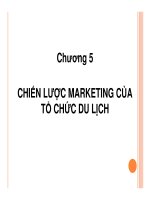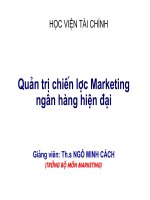slide CHIẾN LƯỢC MARKETING:COLLECTING AND ANALYZING MARKETING INFORNATION
Bạn đang xem bản rút gọn của tài liệu. Xem và tải ngay bản đầy đủ của tài liệu tại đây (1.28 MB, 25 trang )
TRƯỜNG ĐẠI HỌC VĂN LANG
KHOA THƯƠNG MẠI
CHAPTER 3: COLLECTING AND ANALYZING
MARKETING INFORNATION
ThS. Nguyễn Quốc Vương
CHAPTER
3
Collecting
and
Analyzing
Marketing
Information
© 2014 Cengage Learning. All Rights Reserved. May not be scanned, copied or duplicated, or posted to a publicly accessible website, in whole or in part.
Issues to Be Considered in a
Situation
Analysis (Exhibit 3.1)
2
© 2014 Cengage Learning. All Rights Reserved. May not be scanned, copied or duplicated, or posted to a publicly accessible website, in whole or in part.
Conducting a Situation Analysis
Analysis
Data
Alone Is Not a Solution
Is Not the Same as Information
Data – a collection of numbers or facts that have the
potential
to provide information
Information – data that have been transformed or
combined with other data in a manner that makes them
useful to decision makers
The
Benefits of Analysis Must Outweigh the Costs
Conducting
a Situation Analysis is a
Challenging Exercise
Should provide a complete picture of three key
environments: Internal, Customer, and External
3
Internal, Customer, and
External
Environments (Exhibit 3.2)
4
© 2014 Cengage Learning. All Rights Reserved. May not be scanned, copied or duplicated, or posted to a publicly accessible website, in whole or in part.
Of the three major environments in a
situation analysis (internal,
customer, external), which do you
think is the most important in a
general sense? Why? What are
some situations that would make
one environment more important
than the others?
5
© 2014 Cengage Learning. All Rights Reserved. May not be scanned, copied or duplicated, or posted to a publicly accessible website, in whole or in part.
Ba mơi trường chính trong phân tích
(nội bộ, khách hàng, bên ngồi),
theo nghĩa chung, mơi trường nào là
quan trọng nhất? Tại sao? Một số
tình huống có thể làm cho một mơi
trường quan trọng hơn các mơi
trường khác là gì?
5
© 2014 Cengage Learning. All Rights Reserved. May not be scanned, copied or duplicated, or posted to a publicly accessible website, in whole or in part.
The Internal Environment
(Exhibit 3.3)
Review
of Current Objectives, Strategy
and Performance
An important input to later stages in the
planning process
Poor or declining performance must be the
result of:
Goals or objectives that are inconsistent with the customer
or external environments
Flawed marketing strategy
Poor implementation
Changes in the customer or external environments that
are beyond the control of the firm
6
© 2014 Cengage Learning. All Rights Reserved. May not be scanned, copied or duplicated, or posted to a publicly accessible website, in whole or in part.
The Internal Environment
(Exhibit 3.3) (continued)
Availability
of Resources
Includes a review of financial, human, and
experience resources, as well as resources
from key relationships
Financial resources tend to get most attention
Organizational
Culture and Structure
Problems can arise when marketing does not
hold a prominent position in the
organizational hierarchy
Culture and structure are relatively stable but can be
affected by mergers
7
© 2014 Cengage Learning. All Rights Reserved. May not be scanned, copied or duplicated, or posted to a publicly accessible website, in whole or in part.
The Customer Environment
(Exhibit 3.4)
Who
are our Current and Potential Customers?
What
do Customers do with our Products?
Where
When
do Customers Purchase our Products?
do Customers Purchase our Products?
Why
(and How) do Customers Select our
Products?
Why
do Potential Customers not Purchase
our Products?
8
© 2014 Cengage Learning. All Rights Reserved. May not be scanned, copied or duplicated, or posted to a publicly accessible website, in whole or in part.
Understanding the motivations of a
firm’s noncustomers is often just as
important as understanding its
customers. Look again at the
reasons
why an individual
would not purchase
a firm’s products. How can a firm
reach out to noncustomers and
successfully convert them to
customers?
9
© 2014 Cengage Learning. All Rights Reserved. May not be scanned, copied or duplicated, or posted to a publicly accessible website, in whole or in part.
Hiểu được động cơ của những
người không phải khách hàng của
một công ty thường cũng quan
trọng như hiểu khách hàng của
cơng ty đó.
Tại sao một cá nhân khơng mua sản
phẩm của cơng ty. Làm thế nào một
cơng ty có thể tiếp cận với những
khách hàng không quen và chuyển đổi
thành cơng họ thành khách hàng?
9
© 2014 Cengage Learning. All Rights Reserved. May not be scanned, copied or duplicated, or posted to a publicly accessible website, in whole or in part.
The External Environment
(Exhibit 3.5)
Competition
Economic
Political
Legal
Growth and Stability
Trends
and Regulatory Issues
Technological
Sociocultural
Advancements
Trends
10
© 2014 Cengage Learning. All Rights Reserved. May not be scanned, copied or duplicated, or posted to a publicly accessible website, in whole or in part.
The Competitive Environment
Brand
Competitors
Market products with similar features and benefits to
the same customers at similar prices
Product
Generic
Competitors
Market very different products that solve the same
problem or satisfy the same basic customer need
Total
Competitors
Compete in the same product class, but with products
that are different in features, benefits, and price
Budget Competitors
Compete for the limited financial resources of
the same customers
11
© 2014 Cengage Learning. All Rights Reserved. May not be scanned, copied or duplicated, or posted to a publicly accessible website, in whole or in part.
Major Types of
Competition
(Exhibit 3.6)
12
© 2014 Cengage Learning. All Rights Reserved. May not be scanned, copied or duplicated, or posted to a publicly accessible website, in whole or in part.
Stages of Competitive Analysis
Identification
Identify all current and potential competitors
Characteristics
Assess key competitors’ size, strategy, profitability,
markets, etc.
Assessment
Assess key competitors’ strengths and weaknesses
Capabilities
Focus the analysis on competitors’ marketing
capabilities
Response
Estimate competitors’ most likely strategies and
© 2014 Cengage Learning. All Rights Reserved. May not be scanned, copied or duplicated, or posted to a publicly accessible website, in whole or in part.
13
Economic Growth and Stability
Economic
change is inevitable and has a
profound impact on marketing strategy.
General
Economic Conditions
Inflation, employment, income, interest rates,
taxes, trade restrictions, tariffs, business cycle
Consumer
Willingness to spend, confidence, spending
patterns
An
Issues
Underreported Economy
The U.S. economy is dominated by intangibles such as
services and information.
Innovation, creativity, and human assets are not
counted in yearly GDP statistics.
Political, Legal, and Regulatory
Issues
The
views of elected officials can affect
marketing strategy.
Example hot-button issues: tobacco, immigration,
taxes, retirement, healthcare
Lobbying is vital to marketing strategy in highly
regulated
industries.
Firms
must abide by the law, but many laws
are vague and difficult to enforce.
Example key issues: court decisions, corporate
governance, trade agreements
15
© 2014 Cengage Learning. All Rights Reserved. May not be scanned, copied or duplicated, or posted to a publicly accessible website, in whole or in part.
Technological Advancements
Technology
refers to the processes used to
create “things” considered to be new.
Frontstage
Technology
Advances that are noticeable to customers…what
customers think of when they think of technological
advancements
Examples: smartphones, GPS, microwave ovens
Backstage
Technology
Advances that are not noticeable to
customers…these advances make marketing
activities more efficient and effective
Examples: computer technology, RFID,
near-field communication
16
© 2014 Cengage Learning. All Rights Reserved. May not be scanned, copied or duplicated, or posted to a publicly accessible website, in whole or in part.
Sociocultural Trends
Social
and cultural influences that cause changes
in attitudes, beliefs, norms, customs, and lifestyles
Sociocultural
forces can have a profound effect on
the way customers live and buy products.
Changes
in customer demographics and
values have a considerable impact on
marketing.
17
© 2014 Cengage Learning. All Rights Reserved. May not be scanned, copied or duplicated, or posted to a publicly accessible website, in whole or in part.







